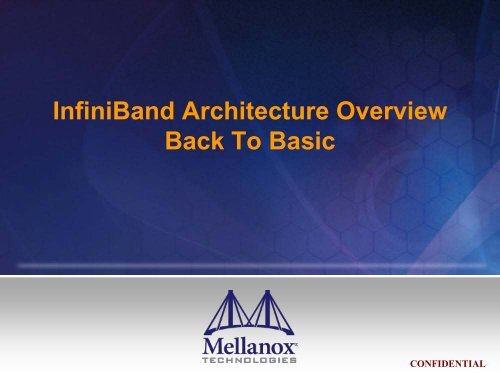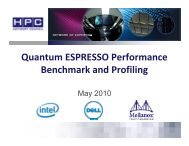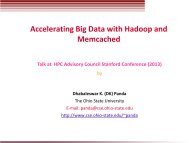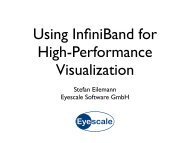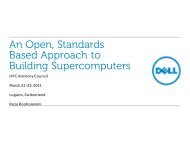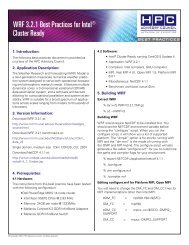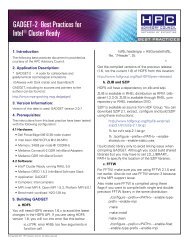InfiniBand Architecture Overview - HPC Advisory Council
InfiniBand Architecture Overview - HPC Advisory Council
InfiniBand Architecture Overview - HPC Advisory Council
You also want an ePaper? Increase the reach of your titles
YUMPU automatically turns print PDFs into web optimized ePapers that Google loves.
<strong>InfiniBand</strong> <strong>Architecture</strong> <strong>Overview</strong><br />
Back To Basic<br />
CONFIDENTIAL
<strong>InfiniBand</strong> Technical <strong>Overview</strong><br />
What is <strong>InfiniBand</strong>?<br />
• <strong>InfiniBand</strong> is an open standard, interconnect protocol<br />
developed by the <strong>InfiniBand</strong>® Trade Association:<br />
http://www.infinibandta.org/home<br />
• First <strong>InfiniBand</strong> specification was released in 2000<br />
What does the specification includes?<br />
• The specification is very comprehensive<br />
• From physical to applications<br />
<strong>InfiniBand</strong> SW is developed under OpenFabrics Open<br />
source Alliance<br />
• http://www.openfabrics.org/index.html<br />
© 2009 MELLANOX TECHNOLOGIES - CONFIDENTIAL -
Infiniband Feature Highlights<br />
Serial High Bandwidth Links<br />
• 10Gb/s to 40Gb/s HCA links<br />
• Up to 120Gb/s switch-switch<br />
Ultra low latency<br />
• Under 1 us<br />
Reliable, lossless, self-managing fabric<br />
• Link level flow control<br />
• Congestion control<br />
Full CPU Offload<br />
• Hardware Based Transport Protocol<br />
• Reliable Transport<br />
• Kernel Bypass<br />
Memory exposed to remote node<br />
• RDMA-read and RDMA-write<br />
© 2009 MELLANOX TECHNOLOGIES - CONFIDENTIAL -<br />
Quality Of Service<br />
• I/O channels at the adapter level<br />
• Virtual Lanes at the link level<br />
Scalability/flexibility<br />
• Up to 48K nodes in subnet, up to<br />
2 128 in network<br />
3
<strong>InfiniBand</strong> Components<br />
Host Channel Adapter (HCA)<br />
• Device that terminates an IB<br />
link and executes transportlevel<br />
functions and support<br />
the verbs interface<br />
Switch<br />
• A device that routes packets<br />
from one link to another of<br />
the same IB Subnet<br />
Router (coming soon…)<br />
• A device that transports<br />
packets between IBA<br />
subnets<br />
© 2009 MELLANOX TECHNOLOGIES - CONFIDENTIAL -<br />
4
IB <strong>Architecture</strong> Layers<br />
• Physical<br />
– Signal levels and Frequency; Media; Connectors<br />
• Link<br />
– Symbols and framing; Flow control (credit-based); How packets<br />
are routed from Source to Destination<br />
• Network:<br />
– How packets are routed between subnets<br />
• Transport:<br />
– Delivers packets to the appropriate Queue Pair; Message<br />
Assembly/De-assembly, access rights, etc.<br />
• Software Transport Verbs and Upper Layer Protocols<br />
– Interface between application programs and hardware.<br />
– Allows support of legacy protocols such as TCP/IP<br />
– Defines methodology for management functions<br />
© 2009 MELLANOX TECHNOLOGIES - CONFIDENTIAL -<br />
5
<strong>InfiniBand</strong> Layered <strong>Architecture</strong><br />
© 2009 MELLANOX TECHNOLOGIES - CONFIDENTIAL -<br />
6
Physical Layer - Responsibilities<br />
The physical layer specifies how bits are placed on the wire<br />
to form symbols and defines the symbols used for framing<br />
(i.e., start of packet & end of packet), data symbols, and fill<br />
between packets (Idles). It specifies the signaling protocol<br />
as to what constitutes a validly formed packet<br />
<strong>InfiniBand</strong> is a lossless fabric. Maximum Bit Error Rate<br />
(BER) allowed by the IB spec is 10e-12. The physical layer<br />
should guaranty affective signaling to meet this BER<br />
requiermnet<br />
© 2009 MELLANOX TECHNOLOGIES - CONFIDENTIAL -<br />
7
Physical Layer – Link Rate<br />
<strong>InfiniBand</strong> uses serial stream of bits to transfer data<br />
Link width<br />
• 1x – One differential pair per Tx and per Rx<br />
• 4x – Four differential pairs per Tx and per Rx<br />
• 12x - Twelve differential pairs per Tx and per Rx<br />
Link Speed<br />
• Single Dada Rate (SDR) – 2.5 GHz signaling (2.5Gb/s for<br />
1x)<br />
• Doable Data Rate (DDR) – 5 GHz signaling (5Gb/s for 1x)<br />
• Quad Data rate (QDR) - 10 GHz signaling (10Gb/s for 1x)<br />
Link rate<br />
• Multiplication of the link width and link speed<br />
• Most common 4x QDR (40Gb/s)<br />
© 2009 MELLANOX TECHNOLOGIES - CONFIDENTIAL -<br />
8
Physical Layer Cont’<br />
Media types<br />
• PCB: several inches<br />
• Copper: 20m SDR, 10m DDR, 7m QDR<br />
• Fiber: 300m SDR, 150m DDR, 100/300m QDR<br />
• CAT6 Twisted Pair in future.<br />
8 to 10 bit encoding<br />
Industry standard components<br />
• Copper cables / Connectors<br />
• Optical cables<br />
• Backplane connectors<br />
12X Cable 4x CX4 Fiber<br />
4X CX4<br />
© 2009 MELLANOX TECHNOLOGIES - CONFIDENTIAL -<br />
FR4 PCB<br />
4X QSFP<br />
4x QSFP Fiber<br />
9
Link Layer - Responsibilities<br />
The link layer describes the packet format and protocols<br />
for packet operation, e.g. flow control and how packets are<br />
routed within a subnet between the source and destination<br />
Message<br />
Transaction<br />
Packet Packet Packet Packet Packet Packet Packet Packet<br />
Physical Layer<br />
© 2009 MELLANOX TECHNOLOGIES - CONFIDENTIAL -<br />
Message Message<br />
10
Link Layer: Packets<br />
Packets are routable end-to-end fabric unit of transfer<br />
• Link management packets: train and maintain link<br />
operation<br />
• Data packets<br />
– Send<br />
– Read<br />
– Write<br />
– Acks<br />
© 2009 MELLANOX TECHNOLOGIES - CONFIDENTIAL -<br />
11
Link Layer: Payload Size<br />
Maximum Transfer Unit (MTU)<br />
• MTU allowed from 256 Bytes to 4K Bytes (Message sizes<br />
much larger).<br />
• Only packets smaller than or equal to the MTU are transmitted<br />
• Large MTU is more efficient (less overhead)<br />
• Small MTU gives less jitter<br />
• Small MTU preferable since segmentation/reassembly<br />
performed by hardware in the HCA.<br />
• Routing between end nodes utilizes the smallest MTU of any<br />
link in the path (Path MTU)<br />
© 2009 MELLANOX TECHNOLOGIES - CONFIDENTIAL -<br />
12
Link Layer: Virtual Lanes (Quality of Service)<br />
16 Service Levels (SLs)<br />
• A field in the Local Routing Header (LRH) of an <strong>InfiniBand</strong> packet<br />
• Defines the requested QoS<br />
Virtual Lanes (VLs)<br />
• A mechanism for creating multiple channels within a single physical link.<br />
• Each VL:<br />
– Is associated with a set of Tx/Rx buffers in a port<br />
– Has separate flow-control<br />
• A configurable Arbiter control the Tx priority of each VL<br />
• Each SL is mapped to a VL<br />
• IB Spec allows a total of 16 VLs (15 for Data & 1 for Management)<br />
– Minimum of 1 Data and 1 Management required on all links<br />
– Switch ports and HCAs may each support a different number of VLs<br />
• VL 15 is a management VL and is not a subject for flow control<br />
© 2009 MELLANOX TECHNOLOGIES - CONFIDENTIAL -<br />
13
Link Layer: Flow Control<br />
Credit-based link-level flow control<br />
• Link Flow control assures NO packet loss within fabric even in the presence of<br />
congestion<br />
• Link Receivers grant packet receive buffer space credits per Virtual Lane<br />
• Flow control credits are issued in 64 byte units<br />
Separate flow control per Virtual Lanes provides:<br />
• Alleviation of head-of-line blocking<br />
• Virtual Fabrics – Congestion and latency on one VL does not impact traffic with<br />
guaranteed QOS on another VL even though they share the same physical link<br />
Link<br />
Control<br />
Packets<br />
Arbitration<br />
Mux<br />
Credits<br />
Returned<br />
Packets<br />
Transmitte<br />
d<br />
Demux<br />
© 2009 MELLANOX TECHNOLOGIES - CONFIDENTIAL -<br />
Link<br />
Control<br />
Receive<br />
Buffers<br />
14
Link Layer: Example<br />
Transaction<br />
Transaction<br />
Transaction<br />
Message size – up to 2Gbyte<br />
Message<br />
Message<br />
Message<br />
Message<br />
Message<br />
Message<br />
Message<br />
Message<br />
Message<br />
Message<br />
Message<br />
Message<br />
Application accesses HW<br />
to post message request<br />
Message<br />
HW schedules execution<br />
Routable unit of transfer<br />
size 256byte to 4Kbyte<br />
Packet<br />
Packet<br />
Packet<br />
© 2009 MELLANOX TECHNOLOGIES - CONFIDENTIAL -<br />
HW dis-assembles message<br />
to routable units of transfer<br />
link<br />
HW sends packets<br />
on serial link<br />
15
Link Layer: Example<br />
Message<br />
Virtual lanes<br />
Packet<br />
Packet<br />
Packet<br />
Service level<br />
Mapped to Virtual Lane<br />
Packet specifies<br />
service level<br />
Flow control<br />
Physical link<br />
Data sent on serial link<br />
Credit-based flow<br />
control per VL<br />
© 2009 MELLANOX TECHNOLOGIES - CONFIDENTIAL -<br />
Each link in fabric<br />
may support different<br />
number of VLs<br />
link<br />
16
Link Layer: Example<br />
Virtual Lane<br />
Input Buffers<br />
link<br />
Data written into<br />
HCA input buffer per VL<br />
HW Schedules execution<br />
of Message to System Memory<br />
Packet<br />
Packet<br />
Packet<br />
Message<br />
© 2009 MELLANOX TECHNOLOGIES - CONFIDENTIAL -<br />
Data Written to/<br />
Read From<br />
System Memory by HW<br />
Message<br />
Message<br />
Message<br />
Message<br />
Message<br />
Message<br />
Message<br />
Message<br />
Message<br />
Message<br />
Message<br />
Message<br />
Transaction<br />
Transaction<br />
Transaction<br />
17
Link Layer: Addressing<br />
Local ID (LID)<br />
• 16 bit field in the Local Routing Header (LRH) of all IB<br />
packets<br />
• Used to rout packet in an <strong>InfiniBand</strong> subnet<br />
• Each subnet may contain up to:<br />
– 48K unicast addresses<br />
– 16K multicast addresses<br />
Assigned by Subnet Manager at initialization and topology<br />
changes<br />
© 2009 MELLANOX TECHNOLOGIES - CONFIDENTIAL -<br />
18
Layer 2 Forwarding<br />
Switches use FDB (Forwarding Database)<br />
• Based on DLID and SL a packet is sent to the correct<br />
output port.<br />
Multicast Destinations supported!!<br />
SL DLID Payload<br />
Switch<br />
FDB<br />
(DLID to Port)<br />
SL to VL<br />
Table<br />
© 2009 MELLANOX TECHNOLOGIES - CONFIDENTIAL -<br />
Port<br />
Port<br />
Port<br />
Port<br />
Port<br />
Port<br />
Port<br />
Port<br />
Outbound Packet<br />
Inbound Packet<br />
19
Network Layer<br />
Responsibility<br />
• The network layer describes the protocol for routing a<br />
packet between subnets<br />
Globally Unique ID (GUID)<br />
• A 64 bit field in the Global Routing Header (GRH) used to<br />
route packets between different IB subnets<br />
• Every node must have a GUID<br />
• IPv6 type header<br />
© 2009 MELLANOX TECHNOLOGIES - CONFIDENTIAL -<br />
20
Transport Layer – Responsibilities<br />
The network and link protocols deliver a packet to the<br />
desired destination. The transport portion of the packet<br />
delivers the packet to the proper QP and instructs the QP<br />
how to process the packet’s data.<br />
The transport layer is responsible for segmenting an<br />
operation into multiple packets when the message’s data<br />
payload is greater than the maximum transfer unit (MTU) of<br />
the path. The QP on the receiving end reassembles the data<br />
into the specified data buffer in its memory<br />
© 2009 MELLANOX TECHNOLOGIES - CONFIDENTIAL -<br />
21
Transport Layer: Queue Pairs<br />
•QPs are in pairs (Send/Receive)<br />
•Work Queue is the consumer/producer interface to the fabric<br />
•The Consumer/producer initiates a Work Queue Element (WQE)<br />
•The Channel Adapter executes the work request<br />
•The Channel Adapter notifies on completion or errors by writing a<br />
Completion Queue Element (CQE) to a Completion Queue (CQ)<br />
© 2009 MELLANOX TECHNOLOGIES - CONFIDENTIAL -<br />
22
Transport Layer: Work Request Element<br />
Data transfer<br />
• Send work request<br />
– Local gather – remote write<br />
– Remote memory read<br />
– Atomic remote operation<br />
• Receive work request<br />
– Scatter received data to local buffer(s)<br />
Memory management operations<br />
• Bind memory window<br />
– Open part of local memory for remote access<br />
• Send & remote invalidate<br />
– Close remote window after operations’ completion<br />
Control operations<br />
• Memory registration/mapping<br />
• Open/close connection (QP)<br />
© 2009 MELLANOX TECHNOLOGIES - CONFIDENTIAL -<br />
23
Transport Layer: Types Transfer Operations<br />
SEND<br />
• Read message from HCA local system memory<br />
• Transfers data to Responder HCA Receive Queue logic<br />
• Does not specify where the data will be written in remote memory<br />
• Immediate Data option available<br />
RDMA Read<br />
• Responder HCA reads its local memory and returns it to the<br />
Requesting HCA<br />
• Requires remote memory access rights, memory start address, and<br />
message length<br />
RDMA Write<br />
• Requester HCA sends data to be written into the Responder HCA’s<br />
system memory<br />
• Requires remote memory access rights, memory start address, and<br />
message length<br />
© 2009 MELLANOX TECHNOLOGIES - CONFIDENTIAL -<br />
24
Transport Services<br />
Non-connected<br />
Connected<br />
QP<br />
snd<br />
rcv<br />
snd<br />
rcv<br />
QP<br />
QP<br />
snd<br />
rcv<br />
snd<br />
rcv<br />
QP<br />
QP<br />
snd<br />
rcv<br />
snd<br />
rcv<br />
QP<br />
QP<br />
snd<br />
rcv<br />
snd<br />
rcv<br />
QP<br />
QP<br />
snd<br />
rcv<br />
snd<br />
rcv<br />
QP<br />
QP<br />
snd<br />
rcv<br />
snd<br />
rcv<br />
QP<br />
QP<br />
CQ<br />
Unreliable Reliable<br />
rcv<br />
snd<br />
cqe<br />
cmd<br />
snd<br />
rcv<br />
cqe<br />
cmd<br />
QP<br />
CQ<br />
© 2009 MELLANOX TECHNOLOGIES - CONFIDENTIAL -<br />
QP<br />
CQ<br />
rcv<br />
snd<br />
cqe<br />
cmd<br />
snd<br />
rcv<br />
cqe<br />
cmd<br />
UD RD<br />
UC RC<br />
XRC<br />
QP<br />
CQ
Transport Layer: Send operation example<br />
Host A RAM<br />
HCA then consume the WQE,<br />
read the buffer and send to remote side<br />
send completion is generated<br />
Send Queue<br />
Receive Queue<br />
Completion Queue<br />
The send side allocate a send buffer<br />
register it with the HCA, place a send WQE<br />
and ring a doorbell<br />
HCA HCA<br />
© 2009 MELLANOX TECHNOLOGIES - CONFIDENTIAL -<br />
When the packet arrives to the HCA<br />
It consumes a receive WQE, place<br />
the buffer in the appropriate location<br />
and generate a completion<br />
Send Queue<br />
Receive Queue<br />
Completion Queue<br />
Application allocate receive buffer<br />
and place a receive WQE<br />
Host B RAM
Transport Layer: RDMA Write Example<br />
Host A RAM<br />
HCA then consume the WQE,<br />
read the buffer and send to remote side<br />
send completion is generated<br />
Send Queue<br />
Receive Queue<br />
Completion Queue<br />
The send side allocate a send buffer<br />
register it with the HCA, place a send WQE<br />
with the remote side’s virtual address<br />
and ring a doorbell<br />
HCA HCA<br />
© 2009 MELLANOX TECHNOLOGIES - CONFIDENTIAL -<br />
When the packet arrives to the HCA<br />
It checks the address and memory<br />
keys and write to memory directly<br />
Send Queue<br />
Receive Queue<br />
Completion Queue<br />
Application allocate receive buffer<br />
and pass address and keys to<br />
remote side<br />
Host B RAM
Transport Layer: Retransmissions<br />
For reliable transport services (RC, XRC) QPs maintain the<br />
flow of packets and retransmit in case a packet was<br />
dropped<br />
Each packet has a Packet Serial Number (PSN) that is used<br />
by the receiver identify lost packets<br />
The receiver will send ACKs if packets arrive in order and<br />
NACKs otherwise<br />
The send QP maintain a timer to catch cases where<br />
packets did not arrive to the receive QP or ACK was lost<br />
Retransmission is considered a “bad flow” which reduce<br />
performance or may break a connection<br />
© 2009 MELLANOX TECHNOLOGIES - CONFIDENTIAL -<br />
28
Verbs<br />
Verbs are the SW interface to the HCA and the IB fabric<br />
Verbs are not API but rather allow flexibility in the API<br />
implementation while defining the framework<br />
Some verbs for example<br />
• Open/Query/Close HCA<br />
• Create Queue Pair<br />
• Query Completion Queue<br />
• Post send Request<br />
• Post Receive Request<br />
Upper Layer Protocols (ULPs) are application writing over<br />
the verbs interface that bridge between standard interfaces<br />
like TCP/IP to IB to allow running legacy application intact<br />
© 2009 MELLANOX TECHNOLOGIES - CONFIDENTIAL -<br />
29
Management Model<br />
IBA management defines a common management<br />
infrastructure for<br />
• Subnet Management - provides methods for a subnet<br />
manager to discover and configure IBA devices and<br />
manage the fabric<br />
• General management services<br />
– Subnet administration - provides nodes with information gathered<br />
by the SM and provides a registrar for nodes to register general<br />
services they provide<br />
– Communication establishment & connection management<br />
between end nodes<br />
– Performance management - monitors and reports well-defined<br />
performance counters<br />
– And more…<br />
© 2009 MELLANOX TECHNOLOGIES - CONFIDENTIAL -<br />
30
Management Model<br />
SNMP Tunneling Agent<br />
Application-Specific Agent<br />
Vendor-Specific Agent<br />
Device Management Agent<br />
Performance Management Agent<br />
Communication Mgmt (Mgr/Agent)<br />
Baseboard Management Agent<br />
Subnet Administration (an Agent)<br />
General Service Interface<br />
QP1 (virtualized per port)<br />
Uses any VL except 15<br />
MADs called GMPs - LID-Routed<br />
Subject to Flow Control<br />
© 2009 MELLANOX TECHNOLOGIES - CONFIDENTIAL -<br />
Subnet Manager (SM) Agent<br />
Subnet Manager<br />
Subnet Management Interface<br />
QP0 (virtualized per port)<br />
Always uses VL15<br />
MADs called SMPs – LID or Direct-Routed<br />
No Flow Control<br />
31
Management Model – Packets<br />
Management is done using Management Datagram (MAD)<br />
packets<br />
• SMP – Subnet Manager MADs<br />
• GMP – General Management MADs<br />
© 2009 MELLANOX TECHNOLOGIES - CONFIDENTIAL -<br />
32
Subnet Management<br />
Topology Discovery<br />
FDB Initialization<br />
Fabric Maintenance<br />
Subnet<br />
Manager<br />
TCA<br />
System<br />
Memory<br />
Each Subnet must have a<br />
Subnet Manager (SM)<br />
SMA<br />
IB<br />
Switch<br />
SMA<br />
TCA<br />
SMA<br />
Initialization uses<br />
Directed Route MADs:<br />
CPU<br />
HCA<br />
SMA<br />
IB<br />
Switch<br />
SMA<br />
IB<br />
Switch<br />
SMA<br />
TCA<br />
Standby<br />
Standby Subnet<br />
Manager SM<br />
SM<br />
IB<br />
Switch<br />
SMA<br />
TCA<br />
SMA<br />
© 2009 MELLANOX TECHNOLOGIES - CONFIDENTIAL -<br />
LID Route Directed Route Vector LID Route<br />
TCA<br />
MADs use unreliable<br />
datagrams<br />
Every entity (CA, SW, Router)<br />
must support a Subnet<br />
Management Agent (SMA)<br />
Multipathing: LMC Supports<br />
LMC: 1<br />
Multiple LIDS<br />
LID = 6,7<br />
33
Other management entities<br />
Connection Manager (CM)<br />
• Establishes connection between end-nodes<br />
Performance Management (PM)<br />
• Performance Counters<br />
– Saturating counters<br />
• Sampling Mechanism<br />
– Counter works during programmed time period<br />
Baseboard Management (BSM)<br />
• Access Vital Product Data (VPD)<br />
• Bridge to/from IBML devices<br />
– Power Management<br />
– Hot plug in and removal of modules<br />
– Monitoring of environmental parameters<br />
© 2009 MELLANOX TECHNOLOGIES - CONFIDENTIAL -<br />
34
Topologies<br />
There are several common topologies for an IB fabric<br />
• Fat Tree – Most popular. A tree where the HCA are the<br />
leaf of the tree and that allow full bisectional Bandwidth<br />
(BW) between pair of nodes<br />
• Mash – each node is connected to 4 other nodes: positive<br />
and negative X and Y axis<br />
• 3D mash – Each node is connected to 6 other nodes:<br />
positive and negative X, Y and Z axis<br />
• 2D/3D torus – The ends of the 2D/3D mashes are<br />
connected<br />
© 2009 MELLANOX TECHNOLOGIES - CONFIDENTIAL -<br />
35
Topologies – Fat Tree Example<br />
Full Fat Tree / Full CBB<br />
Half Fat Tree / Half CBB<br />
© 2009 MELLANOX TECHNOLOGIES - CONFIDENTIAL -<br />
36
<strong>InfiniBand</strong> Link Speed Roadmap<br />
© 2009 MELLANOX TECHNOLOGIES - CONFIDENTIAL -
38<br />
Thank You<br />
www.mellanox.com<br />
CONFIDENTIAL


